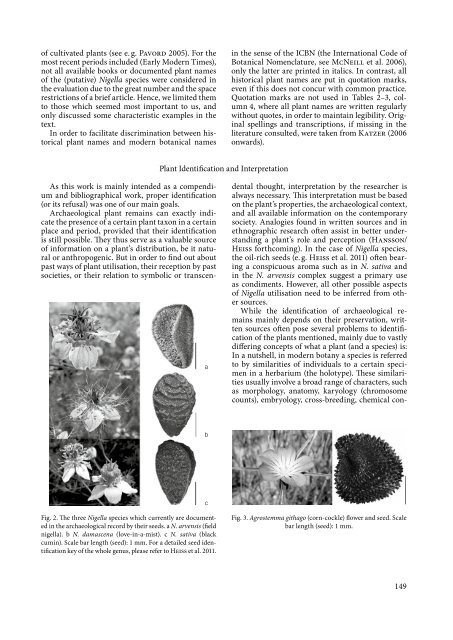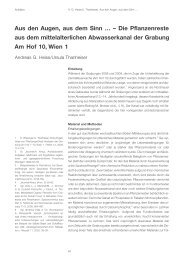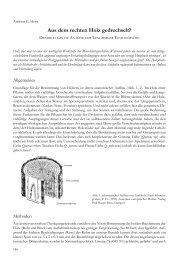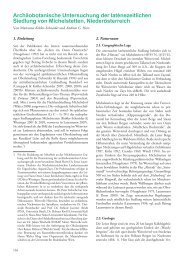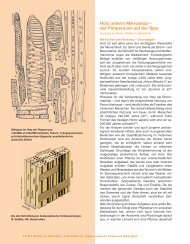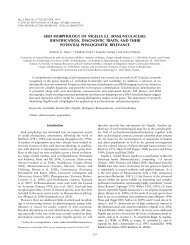View - erbsenzaehler.at
View - erbsenzaehler.at
View - erbsenzaehler.at
You also want an ePaper? Increase the reach of your titles
YUMPU automatically turns print PDFs into web optimized ePapers that Google loves.
of cultiv<strong>at</strong>ed plants (see e. g. Pavord 2005). For the<br />
most recent periods included (Early Modern Times),<br />
not all available books or documented plant names<br />
of the (put<strong>at</strong>ive) Nigella species were considered in<br />
the evalu<strong>at</strong>ion due to the gre<strong>at</strong> number and the space<br />
restrictions of a brief article. Hence, we limited them<br />
to those which seemed most important to us, and<br />
only discussed some characteristic examples in the<br />
text.<br />
In order to facilit<strong>at</strong>e discrimin<strong>at</strong>ion between historical<br />
plant names and modern botanical names<br />
in the sense of the ICBN (the Intern<strong>at</strong>ional Code of<br />
Botanical Nomencl<strong>at</strong>ure, see McNeill et al. 2006),<br />
only the l<strong>at</strong>ter are printed in italics. In contrast, all<br />
historical plant names are put in quot<strong>at</strong>ion marks,<br />
even if this does not concur with common practice.<br />
Quot<strong>at</strong>ion marks are not used in Tables 2–3, column<br />
4, where all plant names are written regularly<br />
without quotes, in order to maintain legibility. Original<br />
spellings and transcriptions, if missing in the<br />
liter<strong>at</strong>ure consulted, were taken from K<strong>at</strong>zer (2006<br />
onwards).<br />
Plant Identific<strong>at</strong>ion and Interpret<strong>at</strong>ion<br />
As this work is mainly intended as a compendium<br />
and bibliographical work, proper identific<strong>at</strong>ion<br />
(or its refusal) was one of our main goals.<br />
Archaeological plant remains can exactly indic<strong>at</strong>e<br />
the presence of a certain plant taxon in a certain<br />
place and period, provided th<strong>at</strong> their identific<strong>at</strong>ion<br />
is still possible. They thus serve as a valuable source<br />
of inform<strong>at</strong>ion on a plant’s distribution, be it n<strong>at</strong>ural<br />
or anthropogenic. But in order to find out about<br />
past ways of plant utilis<strong>at</strong>ion, their reception by past<br />
societies, or their rel<strong>at</strong>ion to symbolic or transcen-<br />
a<br />
dental thought, interpret<strong>at</strong>ion by the researcher is<br />
always necessary. This interpret<strong>at</strong>ion must be based<br />
on the plant’s properties, the archaeological context,<br />
and all available inform<strong>at</strong>ion on the contemporary<br />
society. Analogies found in written sources and in<br />
ethnographic research often assist in better understanding<br />
a plant’s role and perception (Hansson/<br />
Heiss forthcoming). In the case of Nigella species,<br />
the oil-rich seeds (e. g. Heiss et al. 2011) often bearing<br />
a conspicuous aroma such as in N. s<strong>at</strong>iva and<br />
in the N. arvensis complex suggest a primary use<br />
as condiments. However, all other possible aspects<br />
of Nigella utilis<strong>at</strong>ion need to be inferred from other<br />
sources.<br />
While the identific<strong>at</strong>ion of archaeological remains<br />
mainly depends on their preserv<strong>at</strong>ion, written<br />
sources often pose several problems to identific<strong>at</strong>ion<br />
of the plants mentioned, mainly due to vastly<br />
differing concepts of wh<strong>at</strong> a plant (and a species) is:<br />
In a nutshell, in modern botany a species is referred<br />
to by similarities of individuals to a certain specimen<br />
in a herbarium (the holotype). These similarities<br />
usually involve a broad range of characters, such<br />
as morphology, an<strong>at</strong>omy, karyology (chromosome<br />
counts), embryology, cross-breeding, chemical con-<br />
b<br />
c<br />
Fig. 2. The three Nigella species which currently are documented<br />
in the archaeological record by their seeds. a N. arvensis (field<br />
nigella). b N. damascena (love-in-a-mist). c N. s<strong>at</strong>iva (black<br />
cumin). Scale bar length (seed): 1 mm. For a detailed seed identific<strong>at</strong>ion<br />
key of the whole genus, please refer to Heiss et al. 2011.<br />
Fig. 3. Agrostemma githago (corn-cockle) flower and seed. Scale<br />
bar length (seed): 1 mm.<br />
149


